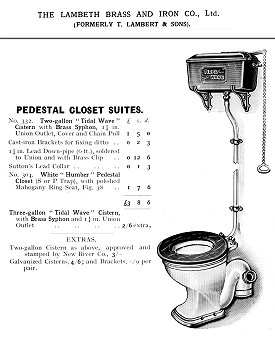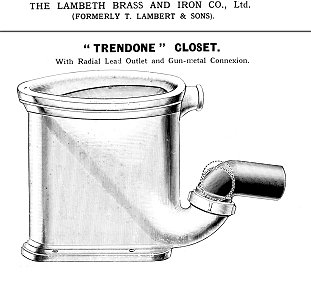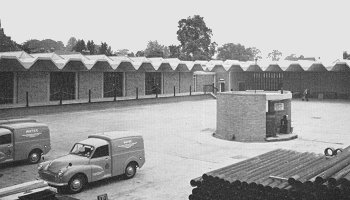|
Sewage
In 1854 the Corporation’s Public Works Committee engaged Robert
Rawlinson to design a sewage system for the Borough. After he had been
at work on the project for about a year he was offered the post of
Sanitary Commissioner for India and so he left Wolverhampton and moved
abroad. His leaving delayed the Borough’s sewage works plans for many
years. In 1859 the Council formed a Sewerage Committee, with the
following members:
Mr. Ironmonger, Mr. Walker, Mr. Foster, Mr. Simkiss, Mr. Kettle, Mr.
E. Perry, Mr. Clark and Mr. Hicklin. They were asked to look thoroughly
into a suitable sewage scheme and report to the Council at an early
date.
|
|

An advert from 1901.
|
In 1861 the Committee reported that a number of
large towns with various systems of sewerage had been visited
and inspected, and the Committee recommended that the Council
should spend £35,000 on a scheme which the members had
developed. At the Council’s meeting there was much opposition,
but the report was carried by just 3 votes. Many people spoke
out against the expenditure including Mr. Sidney and Mr.
Underhill. Mr. Fowler, who was in favour of the scheme was
shouted down every time he tried to speak and the meeting
unanimously passed a resolution condemning the proposal in the
strongest terms. |
| The proposed sewage scheme did not go away
however. The Council were stirred into action by an article in
the ‘Times’ which referred to Wolverhampton as suffering from
all manner of pestilential diseases and having the most
deplorable sanitary condition. There were 931 deaths in just 91
days and the situation was getting worse. The Council authorised
the Sewerage Committee to apply to the Local Government Board
for sanction to borrow £35,000 as a loan for the Deep Drainage
Works of the Borough. |
| After much delay the Committee recommended that
the Council should purchase Barnhurst Farm, Oxley, from Mr. Shaw
Helier for the sum of £27,915. The rain water from the streets
would run into deep drains and be conveyed along with the sewage
to Barnhurst Farm, where it would be treated. The Council
adopted the recommendation and the farm was purchased in June
1868. The foundation stone on the sewage duct was laid by John
Hawksford, Chairman of the Sewerage Committee and the treatment
plant was up and running by the autumn of 1870. |

An advert from 1901.
|
| The scheme adopted was known as the downward
intermittent filtration system. The water and sewage ran
directly on to the 300 acres of farm land after going through
subsiding tanks and passing through the soil. The whole sewage
was filtered and purified, and the effluent, as clean water,
passed from the land into Pendeford Brook via underground pipes.
Unfortunately the system was inadequate, because during heavy
rain the volume of water was so great that the sewage was
carried directly into Pendeford Brook and the fields were
flooded. This caused the Brook to overflow and adjacent
landowners sued the Corporation and claimed enormous damages
which the Corporation had to pay. |
|

The Water Department's offices and works
at Tettenhall.
|
The Corporation also purchased a further 337 acres
of land and began to use the tank bacteria system. After two
years this was abandoned because of the large amounts of acid
and iron from the sewers which interfered with the process. The
problem was solved with the introduction of a dual system in
which the sewage was partly dealt with using downward filtration
and partly by a process known as lime filtration. |
| Large buildings and machinery were erected at
Barnhurst works and parts of the farm not suitable for sewage
were used for cattle and general agriculture.
As a result of the scheme the death rate was much lower and the
Health of the Borough greatly improved.
Work on a new sewage treatment plant began in 1925 and was completed
by 1933. Approximately £300,000 was spent on the project which occupied
60 acres of the original sewage farm adjoining Oxley Moor Road. In the
1950s the new works treated 8,277,000 gallons each day and removed 92
percent of the polluting matter from the waste water. Subsidiary plants
were built at Merry Hill and Coven Heath and a service was offered to
industrialists who needed facilities for the disposal of trade
effluents. In the early 1970s the Corporation’s works were treating a
total of 100,000,000 gallons of polluted water daily.
In the early 1970s a ten year scheme began to replace the existing
sewage system. The scheme, which cost over £8,000,000 separates the foul
and surface water and can handle even larger volumes of sewage for
treatment.
|
 |
|

|
|

|
Return to
A Municipal Water Supply |
|
Return to
the beginning |
|
Proceed to
Bibliography
|
|